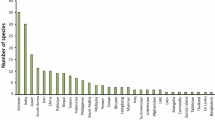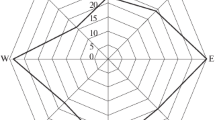Abstract
Polistes is one of the most widely distributed and extensively studied primitively eusocial wasps. Based on where they are found, there are two established nesting cycles in this genus. The temperate wasps follow an annual cycle with diapause in winter while the tropical wasps of South America can initiate nests any time of the year and do not hibernate. Additionally, some subtropical Polistes are known to form nest free aggregations during the cold, dry, unfavorable season. Although several species of Polistes wasps are found in India, our knowledge about their biology is pitifully small and is restricted to taxonomic reports. Here, we report the unique nesting cycle of Polistes wattii, a wasp abundantly found in north India and other Asian countries. P. wattii hibernates in winter as well as forms nest-free aggregations in the dry summer season and thus has a nesting cycle with two inactive periods, which no other Polistes is known to follow. The study site in North India experiences short, cold, snow-free winters, spring, a very dry early summer, and humid late summer with intermittent rain. We found that P. wattii here shows several unique adaptations to survive the long Indian summer where it shows two rounds of nest-founding in the same year, once as overwintered, solitary foundress in spring and once with multiple foundresses during summer. To meet the demands of expanding colony in late summer, P. wattii often adds multiple combs to their nest, which are architecturally different from the multiple comb nests reported from neotropical regions and strikingly different from all temperate Polistes who make only single comb nests. This study investigates the nesting biology and natural history of P. wattii to understand how they maximize survival and fitness.








Similar content being viewed by others
References
Alam SM (1959) Some interesting revelations about the nest of Polistes hebroeus Fabr. (Vespidae, Hymenoptera)–the common yellow wasp of India. In Proc Zool Soc 11:113–122
Beani L (2006) Parasite-induced behavioural changes: an open question. Ann Zool Fenn 43:564–574
Beani L, Calloni C (1991) Leg tegumental glands and male rubbing behaviour at leks in Polistes dominulus (Hymenoptera: Vespidae). J Insect Behav 4:449–462. https://doi.org/10.1007/BF01049330
Beani L, Turillazzi S (1988) Alternative mating tactics in males of Polistes dominulus (Hymenoptera: Vespidae). Behavioral Ecology Behav Ecol Sociobi. Alternative mating tactics in males of Polistes dominulus (Hymenoptera: Vespidae). Behav Ecol Sociobiol 22:257–264. https://doi.org/10.1007/BF00299840
Beani L, Turillazzi S (1990) Male swarms at landmarks and scramble competition polygyny in Polistes gallicus (Hymenoptera: Vespidae). J Insect Behav 3:545–556. https://doi.org/10.1007/BF01052017
Beani L, Dallai R, Mercati D et al (2011) When a parasite breaks all the rules of a colony: morphology and fate of wasps infected by a strepsipteran endoparasite. Anim Behav 82:1305–1312. https://doi.org/10.1016/j.anbehav.2011.09.012
Beani L (2006b). Crazy wasps: when parasites manipulate the Polistes phenotype. In Annales Zoologici Fennici 43: 564–574. Finnish Zoological and Botanical Publishing Board.
Carpenter JM (1996) Distributional checklist of species of the genus Polistes (Hymenoptera: Vespidae; Polistinae, Polistini). Am Mus Novit 3188:1–39
Dapporto L, Palagi E (2006) Wasps in the shadow: looking at the pre-hibernating clusters of Polistes dominulus. AnnZool Fenn 43:583–594
Das BP, Gupta VK (1989) The social wasps of India and the adjacent countries (Hymenoptera: Vespidae). Oriental Insects Monograph 11:1–292
Castro L, Dvořák L (2010) New and noteworthy records of vespid wasps (Hymenoptera: Vespidae) from the Palaearctic region (III). Acta Musei Moraviae, Scientiae biologicae (Brno), 95(2), 37–53.
Evans HE (1958) The evolution of social life in wasps Proceedings of 10th International Congress of Entomology, Montreal 1956, 2:449–457
Folmer O, Black M, Hoeh W et al (1994) DNA primers for amplification of mitochondrial cytochrome c oxidase subunit I from diverse metazoan invertebrates. Mol Mar Biol Biotechnol 3:294–299. https://doi.org/10.1071/ZO9660275
Furuichi S, Kasuya E (2013) Costs, benefits, and plasticity of construction of nest defensive structures in paper wasps. Behav Ecol Sociobiol 68:215–221. https://doi.org/10.1007/s00265-013-1636-0
Furuichi S, Kasuya E (2015) Construction of nest defensive structure according to offspring value and its effect on predator’s attack decision in paper wasps. Ethology 121:609–616. https://doi.org/10.1111/eth.12374
Gadagkar R (2001) The social biology of Ropalidia marginata toward understanding the evolution of eusociality. Harvard University Press, Cambridge, Massachusetts
Gobbi N, Noll FB, Penna MAH (2006) “Winter” aggregations, colony cycle, and seasonal phenotypic change in the paper wasp Polistes versicolor in subtropical Brazil. Naturwissenschaften 93:487–494. https://doi.org/10.1007/s00114-006-0140-z
Hall T (1999) BioEdit: a user-friendly biological sequence alignment editor and analysis program for Windows 95/98/NT. In Nucleic Acids Symp Ser 41:95–98
Hughes DP, Beani L, Turillazzi S, Kathirithamby J (2003) Prevalence of the parasite Strepsiptera in Polistes as detected by dissection of immatures. Insectes Soc 50:62–68. https://doi.org/10.1007/s000400300010
Hughes DP, Kathirithamby J, Turillazzi S, Beani L (2004) Social wasps desert the colony and aggregate outside if parasitized: parasite manipulation? Behav Ecol 15:1037–1043. https://doi.org/10.1093/beheco/arh111
Hunt JH (2007) The evolution of social wasps. Oxford University Press
Hunt JH, Brodie RJ, Carithers TP, Goldstein PZ, Janzen DH (1999) Dry season migration by Costa Rican lowland paper wasps to high elevation cold dormancy sites. Biotropica 31:192–196. https://doi.org/10.1111/j.1439-0310.1987.tb00661.x
Jeanne RL (1975) The adaptiveness of social wasp nest architecture. Q Rev Biol 50(3):267–287
Jeanne RL (1979) Construction and utilization of multiple combs in Polistes canadensis in relation to the biology of a predaceous moth. Behav Ecol Sociobiol 4:293–310
Jeanne RL, Bouwma AM (2004) Divergent patterns of nest construction in eusocial wasps. J Kansas Entomol Soc 77:429–447
Kumar PG, Sharma G (2014) Taxonomic studies on vespid wasps ( Vespidae : Vespoidea : Hymenoptera : Insecta ) of Rajasthan, India with six new records from the state. J New Biol Reports 3:240–258
Kumar S, Stecher G, Tamura K (2016) MEGA7: Molecular Evolutionary Genetics Analysis Version 7.0 for Bigger Datasets. Mol Biol Evol 33:1870–1874. https://doi.org/10.1093/molbev/msw054
Ono M (1989) Multiple-comb nest foundation by a single inseminated worker of the temperate paper wasp, Polistes snelleni Saussure (Hymenoptera: Vespidae). J Ethol 7:57–58. https://doi.org/10.1007/BF02350583
Page RE, Post DC, Metcalf RA (1989) Satellite nests, early males, and plasticity of reproductive behaviour in a paper wasp. Am Nat 134:731–748. https://doi.org/10.1086/285008
Pham PH (2014). Hibernation on the nest of the paper wasp, Polistes (Gyrostoma) olivaceus (De Geer)(Hymenoptera: Vespidae). In Biological forum (6(1):116). Research Trend.
Pickett KM, Carpenter JM, Wheeler WC (2006) Systematics of Polistes (Hymenoptera: Vespidae), with a phylogenetic consideration of Hamilton’s haplodiploidy hypothesis. Ann Zool Fennici 43:390–406
Rad SP, Abbasi R, Soleimani G, Dvořák L (2010) New and supplementary information on the vespid fauna of Iran: (Hymenoptera: Vespidae). Zool Middle East 50:95–100. https://doi.org/10.1080/09397140.2010.10638417
Rambaut A (2009). FigTree. Tree figure drawing tool. https://www.tree. bio. ed. ac. uk/software/figtree/.
Reeve HK (1991) Polistes. In: Ross KG, Matthews RW (eds) The social biology of wasps. Cornell University Press, Ithaca, NY, pp 99–148
Ronquist F, Teslenko M, Van Der Mark P et al (2012) Mrbayes 3.2: Efficient bayesian phylogenetic inference and model choice across a large model space. Syst Biol 61:539–542. https://doi.org/10.1093/sysbio/sys029
Santos BF, Payne A, Pickett KM, Carpenter JM (2015) Phylogeny and historical biogeography of the paper wasp genus Polistes (Hymenoptera: Vespidae): implications for the overwintering hypothesis of social evolution. Cladistics 31:535–549. https://doi.org/10.1111/cla.12103
Sen R, Gadagkar R (2010) Natural history and behaviour of the primitively eusocial wasp Ropalidia marginata (Hymenoptera: Vespidae): a comparison of the two sexes. J Nat Hist 44(15–16):959–968. https://doi.org/10.1080/00222931003615703
Siddiqui JA, Bodlah I, Carpenter JM et al (2015) Vespidae (Hymenoptera) of the Pothwar region of Punjab, Pakistan. Zootaxa 3914:501–524. https://doi.org/10.11646/zootaxa.3914.5.1
Southon RJ, Bell EF, Graystock P, Sumner S (2015) Long live the wasp: adult longevity in captive colonies of the eusocial paper wasp Polistes canadensis (L.). PeerJ 2015:1–18. https://doi.org/10.7717/peerj.848
Strassmann JE (1981) Evolutionary implications of early male and satellite nest production in Polistes exclamans colony cycles. Behav Ecol Sociobiol 8:55–64. https://doi.org/10.1007/BF00302844
Strassmann JE (1991) Costs and benefits of colony aggregation in the social wasp, Polistes annularis. Behav Ecol 2:204–209. https://doi.org/10.1093/beheco/2.3.204
Tannure-Nascimento IC, Nascimento FS, Zucchi R (2005) Size and colony cycle in polistes satan, a neotropical paper wasp (Hymenoptera Vespidae). Ethol Ecol Evol 17:105–119. https://doi.org/10.1080/08927014.2005.9522601
Thompson JD, Higgins DG, Gibson TJ (1994) CLUSTAL W: Improving the sensitivity of progressive multiple sequence alignment through sequence weighting, position-specific gap penalties and weight matrix choice. Nucleic Acids Res 22:4673–4680. https://doi.org/10.1093/nar/22.22.4673
Turbyville JC, Dunford JC, Nelson MR (2013) Hymenoptera of Afghanistan and the central command area of operations: assessing the threat to deployed U.S. service members with insect venom hypersensitivity. Allergy Asthma Proc 34:179–184. https://doi.org/10.2500/aap.2013.34.3638
van der Vecht J (1965) The geographical distribution of the social wasps (Hymenoptera: Vespidae) Proceedings of 12th International Congress of Entomology, London 1964) pp 440–441
West-Eberhard MJ (1969) The social biology of Polistine wasps. Misc Publ Mus Zool Univ Mich 140:1–101
Wetterer JK (1991) Allometry and the geometry of leaf-cutting in Atta cephalotes. Behav Ecol Sociobiol 29:347–351. https://doi.org/10.1007/BF00165959
Acknowledgements
The authors are grateful to Dr Girish Kumar for helping with the identification of the wasp species. RS is indebted to Prof. Raghavendra Gadagkar for his comments on a previous version of the manuscript and Jesse Hotelling for sharing his knowledge and enthusiasm about Polistes wasps. We thank Dr. Neetu Batra for the top picture in Figure 3 and Ms. Akshita Sharma for helping with data collection. We thank the Department of Forests and Wildlife, Chandigarh Administration and Department of Forests and Wildlife Preservation, Punjab, for the permit and NOC to collect wasps.
Funding
The work was partially supported by the SERB-CRG grant CRG/2021/007010 awarded to RS and RR. KM was supported with a BS-MS fellowship, PS, and SS with Summer Internships and RK with a post-doctoral fellowship, all from IISER Mohali. MG was supported by the UGC-JRF scholarship. DN was supported by DST-INSPIRE fellowship (DST/INSPIRE/03/2021/000175, IF200146).
Author information
Authors and Affiliations
Contributions
DB, MD, SS, and KM collected the census data; SS, PS, and DN dissected and measured the wasps; RK helped with the initial standardization of the model as well as nest collection; she was the first one to notice the double initiation strategy. MG and KM did the sequencing and phylogenetic analysis. RR supervised the phylogenetic analysis. RS designed the study, collected nests, supervised data collection, analyzed the data, and wrote the paper with RR.
Corresponding author
Ethics declarations
Competing interests
The authors declare no competing interests.
Additional information
Communicated by: Sean O'Donnell
Publisher's note
Springer Nature remains neutral with regard to jurisdictional claims in published maps and institutional affiliations.
Supplementary Information
Below is the link to the electronic supplementary material.
Rights and permissions
About this article
Cite this article
Sen, R., Malhotra, K., Gupta, M. et al. Coping with the ‘Indian summer’: unique nesting cycle and nest architecture of the paper wasp, Polistes wattii. Sci Nat 109, 31 (2022). https://doi.org/10.1007/s00114-022-01801-0
Received:
Revised:
Accepted:
Published:
DOI: https://doi.org/10.1007/s00114-022-01801-0




